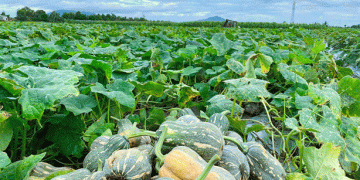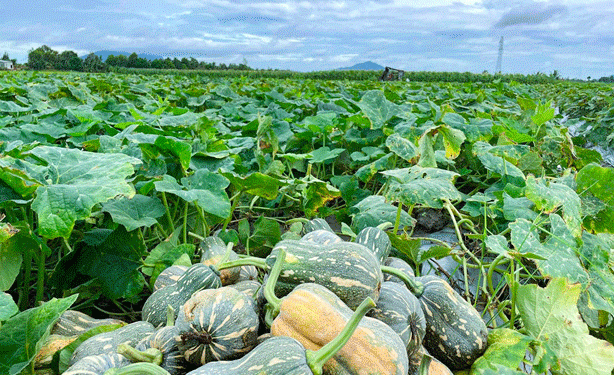In the fertile fields of Nam Đàn district, farmers are currently engaged in a bustling pumpkin harvest, spurred by an unprecedented increase in prices. Following recent heavy rains and flooding, the supply of green vegetables has dwindled, resulting in pumpkin prices skyrocketing to 10,000-11,000 VND per kilogram, which is approximately 2.5 times the prices seen last year. This price surge has transformed pumpkin cultivation into a lucrative opportunity for farmers in the area.
The Rise of Pumpkin Farming in Thượng Tân Lộc
The pumpkin has become a cornerstone crop for the farmers of Thượng Tân Lộc, with 90 hectares under cultivation and approximately 700 households involved in its production. Local farmer Trần Xuân Hùng, Director of the Thượng Tân Lộc Agricultural Services Cooperative, highlights the pumpkin’s resilience: “This crop has adapted well to the local soil for three years now. It’s drought-resistant, easy to care for, and yields well.” Farmers typically plant pumpkins in early June, allowing for harvesting from September through October.
With each hectare costing between 800,000 and 1 million VND to cultivate, the financial returns this season are particularly encouraging. One local farmer, Nguyễn Thị Hiên, shared that her family planted 4 sào (approximately 0.4 hectares) of pumpkins and is on track to harvest around 2 tons this season. After covering expenses, she anticipates earning around 20 million VND, a significant boost for her household.
Market Demand and Quality
The Thượng Tân Lộc pumpkin, known for its aromatic flavor and smooth texture, is highly sought after in the market. Weighing between 1 and 1.5 kilograms, these pumpkins are not only sold at maturity but also harvested during their growth stages. The tender shoots and flowers are sold as nutritious vegetables, fetching prices between 10,000 and 15,000 VND per kilogram.
Local trader Nguyễn Thị Hường notes that demand for pumpkins is exceptionally high this year, stating, “I buy every pumpkin they harvest. Some days, I purchase tons of them.” The ease of selling is attributed to the crop’s high quality and the significantly increased prices, which are four times higher than average prices from previous years.
Sustainable Agricultural Practices
Despite the economic advantages of pumpkin cultivation, farmers in Thượng Tân Lộc practice crop rotation rather than intensive farming. Following the pumpkin harvest, many will switch to planting corn or peanuts. This approach not only helps maintain soil health but also reduces the risk of disease, ensuring a sustainable yield of high-quality pumpkins.
The strategic timing of pumpkin cultivation is also noteworthy. The fall and winter months generally see higher prices for pumpkins due to the scarcity of other green vegetables in the market. As reported by agricultural experts, the lack of alternative produce during this season makes pumpkins a critical source of income for farmers.
The current pumpkin harvest in Nam Đàn is a remarkable example of how adaptive farming practices can lead to significant economic gains, especially in the face of challenging weather conditions. With prices at an all-time high, local farmers are reaping the rewards of their labor, demonstrating the potential for strategic crop selection and sustainable farming practices to enhance food security and farmer livelihoods.































